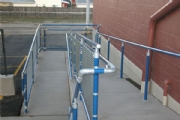 Add My Company
Add My Company
Sign In
Helping hand with access
05-11-2009

The obligations outlined in Building Regulations approved Document M specify that guarding and handrail on all building stairways and ramps do not discriminate against disability group.
Vernon Barry of Kee Safety says: "on access ramp gradients that vary from two to five degrees, handrails need to be positioned on both sides, or centrally for a wide path, to allow the user a choice of arms and support. They should be installed on both sides of ramps that are longer than two metres and should, where possible, extend 300mm beyond the top and bottom of the ramp or staircase. Building regulations stipulate an outside diameter tube size for such installation of between 40mm and 45mm, and must be offset in the case of a mid-height handrail."
External handrails can be part of a façade that is aesthetically attractive
Under the DDA, "reasonable steps" must be taken to ensure disabled users are not at a disadvantage when accessing a public building. A common solution can involve taking out physical structures like steps and replacing them with ramps, or simply providing handrails to aid wheelchair or other disabled users.
Visibility
It is also important that a facility’s external handrails are part of a façade that is aesthetically attractive and makes a good first impression on visitors. "Handrails are required to prevent falls or collisions and should be provided where there is a risk of falling, such as over an edge or down a slope, or where people may walk into obstructions or into the path of traffic", says Barry. "They must be easily visible, but not obtrusive.
For more information on Helping hand with access talk to Kee Safety
Enquire Now
List your company on FindTheNeedle.

